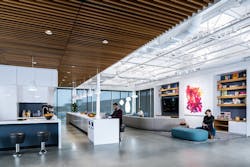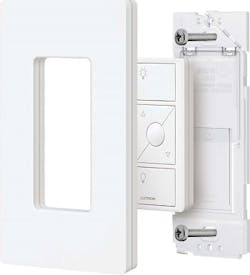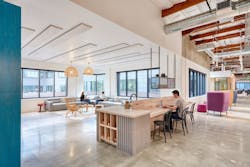Rethinking the Commercial Workspace: How Lighting Facilitates the Return to the Office
After months of remote work, employees are returning to the office. How can you, as a building owner or property manager make that return most appealing? Are your building systems flexible, resilient and poised to handle future changes? Are they designed to help bridge the gap between the home and traditional office and to enhance the long-term value of your property?
Even before we started feeling the impact of the recent pandemic, new systems and technologies were enabling employees to move seamlessly between remote and onsite work. Smart, integrated building systems can be instrumental to supporting this trend, providing data that helps create more comfortable, productive environments and supporting the people who use them every day.
We’ll look at three current workplace trends and discuss how smart lighting control systems can contribute to a more comfortable and engaging environment that meets the changing needs of both tenants and their employees, today and over time:
1. Embracing the hybrid work model
2. Installing flexible building systems that support today’s needs and adapt to whatever tomorrow brings
3. Lighting for wellbeing—optimizing the user experience and continuing to add value over time
[Related: Light Paints the Space at Ketra’s New Austin Headquarters]
Lighting Control to Enhance the Hybrid Work Model
Results of a recent study—Purpose of Place: History and Future of the Office—published by Cushman & Wakefield and the Center for Real Estate and Urban Analysis indicate that a hybrid model that combines onsite and remote work is here to stay: “The post-COVID-19 future will likely be characterized by organizations determining the right balance of remote work to advance their organizational priorities rather than one that sees a move toward an office-free world.”
One approach to the hybrid trend is for the commercial office spaces to adopt a “resimercial” mindset, introducing elements of the home to keep employees more comfortable, creative and productive in the office. This might include providing more personalized control of environments and allowing employees to fine tune the space to their preferences. Warmer color temperatures, for example, or lighting that adjusts over the course of the day may elicit stronger connections between the home and office experience.
As reported in the Purpose of Place study, Glassdoor found that in 2020, 54% of workers reported having some access to a work-from-home option as compared with 28% in 2011. The flexible workplace trend is likely to spur solutions that translate smoothly between the home and the office. App-based, digital wireless lighting, for example, is easily scalable and ideal for a private commercial office or an entire building and can be just as easy to install in the home for greater system familiarity and comfort.
[Related: Inside the Nature-Inspired Design of This Iowa Office]
Install Resilient Lighting Systems that Support Today’s Needs and Adapt to Tomorrow’s
Flexibility is a new benchmark for building systems—and lighting is no different. Lighting systems need to be adaptive to soften today’s transitions back into the workplace, but they also need to be nimble enough to adjust to whatever the future brings. Wireless lighting control is not only simpler to design than wired systems, but it is also more dynamic and resilient than many wired options and can integrate easily with third-party systems (e.g. scheduling and room-reservation software) to streamline building operations.
Digital and wireless solutions contribute to more efficient space management by helping to identify and evaluate occupancy patterns to inform better lighting management. Using this data, building managers can better use the space by rezoning lighting and adding wall controls and sensors without new wiring or opening up walls, enabling them to meet these needs quickly and easily without disrupting building occupants.
Even in an ideal world, lighting requirements change over time. There’s an advantage to systems that simplify maintenance and upgrades without sacrificing timelines or budgets. Wireless solutions can be quickly and easily reprogrammed or rezoned with an app that is frictionless and easy to use, allowing you to reconfigure lighting to meet changing workplace layouts.
Lighting for Wellbeing: Optimize the User Experience
Just as the recent pandemic sped up the adoption of work-from-home policies, it amplified the focus on wellbeing in the workplace. Design frameworks such as the WELL Building Standard, encourage a culture of wellbeing, and may help employers attract and retain high-caliber talent—good news for owners looking to differentiate their properties in a competitive real estate market.
A recent study by HR advisory firm Future Workplace shows that “access to natural light and views of the outdoors are the number one attribute of the workplace environment.” Invest in solutions like dynamic daylight management that integrates automated shades and electric lighting to balance daylight, promote views and reduce glare. Augment natural daylight with state-of-the-art technologies that go beyond static white control to offer dynamic, saturated-color control. These strategies combine to drive natural light deep into a space and bring the outdoors in wherever possible.
But a focus on wellbeing can start with even simple measures that include reducing touches on common surfaces. Touchless lighting controls such as sensors or automated scene control can help minimize the spread of germs, contributing to initiatives that may help keep employees healthier and your tenants happier.
Lighting Can Elevate the Indoor Environment and Add Value to Your Space
Lighting is functional and necessary; it is ubiquitous in any indoor space but lighting also has the power to be an attractive building amenity, a means to more resilient spaces and a system that continues to enhance building value over time. As the workplace changes and evolves, look for digital, wireless lighting and shading solutions that help welcome people back to an office they look forward to coming to.
Embrace systems that suit individual styles and tasks while contributing to the resilience, flexibility and wellbeing of your commercial space. Think of lighting control as part of your total property package; choose a system that helps support the needs of today’s employees and is poised to react to whatever societal, social and environmental changes lay ahead.
About the Author:
Matt Ochs is the senior director of commercial business for Lutron Electronics.
Read next: 4 Hot Lighting Trends for Today’s Facilities
About the Author

Contributed Author
BUILDINGS partners with industry experts to bring you contributed content covering the hot topics for building owners and facility professionals.


